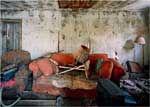NYT:
If this sounds confusing, that’s the nature of chaos, which can be as hard to photograph as it is to describe. Fortunately, Robert Polidori is a connoisseur of chaos, and the beauty of his pictures — they have a languid, almost underwater beauty — entails locating order in bedlam.
The X of wires and the diagonal thrust of that green house, extending horizontally across the photograph, are vertically anchored by the telephone pole, creating a tranquillity in the composition that belies the actual pandemonium. Given bearings by this geometry, a viewer is set free to find details like the teetering stop sign on the street corner where the green house landed: a black-humored punch line.
All artists, as best they can, make sense of a world that is often senseless. Mr. Polidori’s work, from Chernobyl to Havana — in sometimes dangerous, topsy-turvy, out-of-time places — generally bears witness to profound neglect. A photojournalist’s compulsion and problem is always to contrive beauty from misery, and it is only human to feel uneasy about admiring pictures like these from New Orleans, whose sumptuousness can be disorienting. But the works also express an archaeologist’s aspiration to document plain-spoken truth, and they are without most of the tricks of the trade that photographers exploit to turn victims into objects and pictures of pain into tributes to themselves.
Here.

